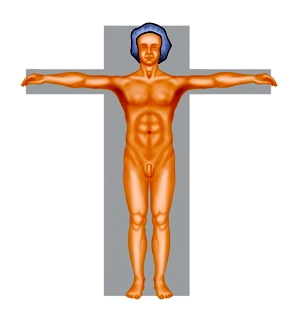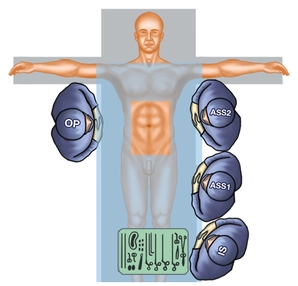- Tumor stenosis of the small intestine or extended stenotic strictures.
- In severe iatrogenic injuries of the small intestine which cannot be oversewn, thus requiring bowel resection.
- Urinary diversion draining the urine via a segment of the ileum excluded from the intestinal passage.
- In status post resection for ischemic small intestine.
- Resections of small intestine invaded by a primary in a different location.
-
Indications
-
Contraindications
- Even in segmental resections of the small intestine, the anastomosis may be a critical factor in healing: For instance, in a severely impaired blood supply or when the comorbidity of the patient is extreme, e.g., in septic shock.
- In such cases, a stoma should be considered and might be more prudent in certain situations, in order not to risk anastomotic failure!
-
Preoperative diagnostic work-up
- Cross-sectional imaging by CT or MRI is indicated in tumors.
- In chronic inflammatory bowel disease, MR enteroclysis (Sellink) imaging is the gold standard today.
- In exceptional cases, simple contrast imaging may be performed with a water-soluble contrast agent (a rather inaccurate study, in ileus cases the contrast agent fades away upstream of the stenosis without resulting in a meaningful image).
- Some cases may call for double-balloon endoscopy or capsule endoscopy, particularly when working up endoluminal findings.
-
Special preparation
- No special preoperative management is required:
- As a rule, it suffices to have the patient fasting during the night, as the small intestine empties rather quickly.
- Flushing with saline or other laxatives is common but, according to the latest data, lacks any positive evidence!
-
Informed consent
- General risks of surgery
In addition:
- Risk of anastomotic failure.
- When considering extensive small intestinal resections – especially in the terminal ileum – the patient should be informed that this may require substitution of vitamin B12, fat-soluble vitamins and calcium for life!
- In planned extensive resections, inform the patient about the risk of short bowel syndrome!
-
Anesthesia
- In general, surgery of the small intestine is carried out under General anesthesia.
- Because of the intrinsic mobility of the small intestine, it can be exteriorized via very small incisions, inspected and, if necessary, resected and anastomosed.
- Thus, concomitant measures such as an epidural catheter are usually not required!
- Postoperative analgesia can be administered with the usual opiates and non-steroidal anti-inflammatory drugs.
- If an epidural catheter has been inserted, it can, of course, be used in postoperative pain management.
-
7. Positioning
![7. Positioning]()
- Standard positioning is with the patient supine
- Both arms abducted
-
Operating room setup
![Operating room setup]()
- Usually, the surgeon is to the right of the patient, with both the first and second assistant facing him/her.
- In some cases, the second assistant may be standing to the left of the surgeon.
- The scrub nurse is on the left of the patient and to the left of the first assistant. Usually, the instrument table is positioned such that the instruments may be placed on the table at the level of the patient's thigh or hip.
-
Special instruments and fixation systems
Usually, a standard retractor system for abdominal surgery is employed.
There are a number of such systems available and common.
-
Postoperative Management
Postoperative analgesia:
Adequate pain therapy; for severe pain add a morphine analogue (e.g., Targin® 1 – 2x 7.5 mg/d); or follow this link to PROSPECT (Procedures Specific Postoperative Pain Management) or this link to the current German guideline [MM1] Behandlung akuter perioperativer und posttraumatischer Schmerzen [Treatment of acute perioperative and posttraumatic pain].[MM2]Postoperative care:
In any case, if there is no backflow, the gastric tube can be removed on postoperative day 1 the latest; and the skin sutures around postoperative day 10.Deep venous thrombosis prophylaxis:
Here, the standards regarding prophylaxis apply, preferably with low molecular weight heparin! Follow this link to the current German guideline Prophylaxe der venösen Thromboembolie [Guideline on prophylaxis in venous thromboembolism] (VTE).[MM3]Ambulation:
On the day of surgery make the patient sit at least at the edge of the bed; ideally, on the day of the operation the patient should be made to sit in a chair and ambulate in the hallway. This is continued during the postoperative phase. Depending on the extent of the laparotomy, the patient should practice intensive breathing exercises with appropriate devices!Physical therapy:
Breathing exercises and physical therapy in bed, if required.Diet:
Return to regular diet varies depending on the level of the anastomosis. In any case, if there is no backflow, the gastric tube can be removed on postoperative day 1 the latest; and return to regular diet is initiated with a liquid diet, i.e., tea and soup. The next steps in the return then depend on the patient’s symptoms. If there is no eructation, vomiting or nausea and if –judging by the clinical examination – the abdomen remains bland, the return can be continued on day 2/3 to soft diet and then regular diet which, however, must be chewed well.Bowel management:
Bowel movement should usually start by postoperative day 3. If this is not the case, it may be managed with the usual laxatives. These include, for example, the administration of magnesium in the morning and evening, and subcutaneous/intravenous sodium picosulfate (Laxoberal®) or prostigmin.Work disability:
Depending on the extent of the operation and the comorbidities, the patient will be hospitalized for at least 5 - 7 days. Work disability will probably last for a minimum of 1–2 weeks after hospital discharge, depending on the convalescence of the patient.The latter is subject to very large interindividual variation and will hinge on the patient's personality and profession.


